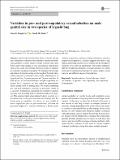Files in this item
Variation in pre- and post-copulatory sexual selection on male genital size in two species of lygaeid bug
Item metadata
| dc.contributor.author | Dougherty, Liam R. | |
| dc.contributor.author | Shuker, David M. | |
| dc.date.accessioned | 2016-03-21T14:30:07Z | |
| dc.date.available | 2016-03-21T14:30:07Z | |
| dc.date.issued | 2016-04 | |
| dc.identifier | 240791285 | |
| dc.identifier | 866f3780-c1b3-40b5-9615-b1be1660dd6c | |
| dc.identifier | 84961061931 | |
| dc.identifier | 000372258200017 | |
| dc.identifier.citation | Dougherty , L R & Shuker , D M 2016 , ' Variation in pre- and post-copulatory sexual selection on male genital size in two species of lygaeid bug ' , Behavioral Ecology and Sociobiology , vol. 70 , no. 4 , pp. 625-637 . https://doi.org/10.1007/s00265-016-2082-6 | en |
| dc.identifier.issn | 0340-5443 | |
| dc.identifier.uri | https://hdl.handle.net/10023/8451 | |
| dc.description | This study was funded by the Natural Environmental Research Council (DTG studentship 1109354 to LRD). | en |
| dc.description.abstract | Sexual selection has been shown to be the driving force behind the evolution of the sometimes extreme and elaborate genitalia of many species. Sexual selection may arise before and/or after mating, or vary according to other factors such as the social environment. However, bouts of selection are typically considered in isolation. We measured the strength and pattern of selection acting on the length of the male intromittent organ (or processus) in two closely related species of lygaeid seed bug: Lygaeus equestris and Lygaeus simulans. In both species, we measured both pre- and post-copulatory selection. For L. equestris, we also varied the experimental choice design used in mating trials. We found contrasting pre- and post-copulatory selection on processus length in L. equestris. Furthermore, significant pre-copulatory selection was only seen in mating trials in which two males were present. This selection likely arises indirectly due to selection on a correlated trait, as the processus does not interact with the female prior to copulation. In contrast, we were unable to detect significant pre- or post-copulatory selection on processus length in L. simulans. However, a formal meta-analysis of previous estimates of post-copulatory selection on processus length in L. simulans suggests that there is significant stabilising selection across studies, but the strength of selection varies between experiments. Our results emphasise that the strength and direction of sexual selection on genital traits may be multifaceted and can vary across studies, social contexts and different stages of reproduction. | |
| dc.format.extent | 13 | |
| dc.format.extent | 840039 | |
| dc.language.iso | eng | |
| dc.relation.ispartof | Behavioral Ecology and Sociobiology | en |
| dc.subject | Genital evolution | en |
| dc.subject | Sexual selection | en |
| dc.subject | Social environment | en |
| dc.subject | Lygaeinae | en |
| dc.subject | Post-copulatory | en |
| dc.subject | Pre-copulatory | en |
| dc.subject | Meta-analysis | en |
| dc.subject | QH301 Biology | en |
| dc.subject.lcc | QH301 | en |
| dc.title | Variation in pre- and post-copulatory sexual selection on male genital size in two species of lygaeid bug | en |
| dc.type | Journal article | en |
| dc.contributor.institution | University of St Andrews. School of Biology | en |
| dc.contributor.institution | University of St Andrews. Scottish Oceans Institute | en |
| dc.contributor.institution | University of St Andrews. Institute of Behavioural and Neural Sciences | en |
| dc.contributor.institution | University of St Andrews. Centre for Biological Diversity | en |
| dc.identifier.doi | 10.1007/s00265-016-2082-6 | |
| dc.description.status | Peer reviewed | en |
This item appears in the following Collection(s)
Items in the St Andrews Research Repository are protected by copyright, with all rights reserved, unless otherwise indicated.

